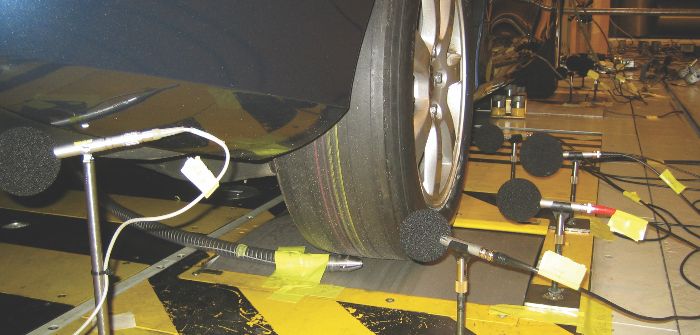As with many other environmental regulations, limits on pass-by noise emissions have become a key factor in any vehicle development cycle. Standards and legal frameworks are constantly evolving, requiring engineers to adapt quickly to new challenges. To make sure all Volvo cars can easily meet future pass-by noise regulations, the Volvo Car Group recently teamed up with Siemens PLM Software. The acoustics engineers chose LMS Test.Lab software, part of the Siemens Simcenter solutions portfolio, to support their design processes.
High customer expectations and a stringent legal framework have made noise emission a defining competitive asset for any type of new road vehicle on the market. Pass-by noise legislation provides car builders with a framework and maximum noise emissions limits, requiring them to prove that their cars, trucks, buses and motorcycles comply with noise regulations.
Investing in acoustic performance
ISO 362 describes how pass-by noise tests should be performed based on environmental and operational conditions, what instruments should be used and the minimal requirements for measurement quality. While the standard defines testing requirements, it does not impose maximum noise emission levels. Governmental bodies, such as the European Council, use legislation to define regional limits. Both increasing traffic and continuous developments in noise emissions have led to several revisions to the ISO 362 standard.
Vehicle speeds in urban areas are generally lower, around 31mph (50km/h), with accelerations rarely exceeding 1m/s. ISO 362:2007 addresses these issues by introducing a combination of WOT and constant speed tests to calculate the overall pass-by noise level.
Volvo Cars invests extensively in analyzing the acoustic performance of every car component, a process that puts high demands on the amount and quality of test data available to engineers. With the current EU pass-by noise regulations being revised and bearing in mind the prospect of emission levels being reduced by at least 3-4 A-weighted decibels, Volvo Cars decided to try the pass-by noise testing module included with LMS Test.Lab in a pilot project to fine-tune its existing testing methods.
A major change in the new approach is the testing location. Although the ISO 362 standard still requires testing on an outdoor test track, new standards are under discussion that would allow certification testing to be performed indoors in a chassis dynamometer (dyno) facility. The advantage of indoor tests is that they are not dependent on weather conditions so productivity can increase and time to market can be reduced.
Separating out the noise
The number of microphones used is impressive: 20 array microphones are installed on each side of the car, while 35 separate microphones (covering seven sources) record powertrain noise levels. The exhaust is represented by three sources, which are registered by 13 microphones, and eight more microphones cover the right-hand side tires. In total, 75 microphones, two speed channels (vehicle and engine), one kick-down channel (triggering the start of tests) and one engine reference accelerometer all feed into the testing system.
The overall pass-by noise level produced by a car is the sum of the noise contribution from different sound sources, mainly the powertrain and tires. As indoor measurements are usually performed with slick tires, indoor pass-by levels mainly consist of powertrain noise. Volvo Cars measures tire noise on an outdoor track by equipping a vehicle with regular tires and having it coast with its engine shut off. This coast-down measurement is then repeated indoors with slicks to improve the overall tire model. The indoor noise testing allows researchers to separate powertrain and tire noise and conduct an in-depth analysis so they can rank individual components.
Gaining insight
For Volvo Cars, initial conclusions from this new measurement method have produced interesting insights into the noise contribution of separate components under various testing conditions. The imminent introduction of constant speed testing, as prescribed in ISO 362:2007, makes these findings particularly relevant.
Tests were conducted using a 2.5-liter, five-cylinder diesel engine with both slick tires and regular tires. Using slick tires, the dominant sources in order of importance were the front tires, powertrain, rear tires, tailpipe and muffler.
In higher gears and at a constant speed, the rear tires proved more important than the powertrain. The tailpipe contribution remained below that of the powertrain in all tests.
Saving time
As a test case, the contribution from all six powertrain sources was reduced by 6dB(A) between 300 and 3,000Hz. Source editing revealed that this led to an overall noise reduction of only about 1.25dB(A). The experiment illustrates the difficulty in achieving even the slightest change in the overall pass-by noise level.
LMS Test.Lab in-room pass-by noise testing gives immediate feedback on the magnitude of modifications when adjusting individual component designs.


